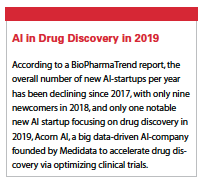Novartis and Microsoft Collaborate on AI Lab
Trend Watch: AI Partnerships and New Therapeutic Candidates
Novartis has founded the Novartis AI innovation lab and is collaborating with Microsoft on the effort. The new lab aims to bolster Novartis AI capabilities from research through commercialization and help accelerate the discovery and development of transformative medicines for patients worldwide.
This strategic alliance focuses on two core objectives, AI empowerment and exploration.
The lab aims to bring the power of AI to the desktop of every Novartis associate. By bringing together vast amounts of Novartis datasets with Microsoft’s advanced AI solutions, the lab will aim to create new AI models and applications that can augment the company’s capabilities to take on the next wave of challenges in medicine.
The lab is using the power of AI to tackle some of the hardest computational challenges within the life sciences, starting with generative chemistry, image segmentation, and analysis for smart and personalized delivery of therapies and optimization of cell and gene therapies at scale.
Microsoft and Novartis are also collaborating to develop and apply next-generation AI platforms and processes that support future programs across these two focus areas. The overall investment will include project funding, subject-matter experts, technology, and tools.
Microsoft is also collaborating with AstraZeneca to form AI Factory for Health — an accelerating program for healthcare startups.
Insilico Medicine Uses Deep Learning to ID Potent DDR1 Kinase Inhibitors
Insilico Medicine is developing a comprehensive drug discovery pipeline using AI to generate novel molecules with the specified properties for a variety of target classes and challenging targets with and without crystal structure rapidly generating lead-like hits. This pipeline was specifically developed to rapidly validate prospective targets with small-molecule chemistry and allow for rapid pharmaceutical drug discovery.
The developer recently published a paper titled, “Deep learning enables rapid identification of potent DDR1 kinase inhibitors," in Nature Biotechnology. The paper describes a timed challenge, where the new AI system called Generative Tensorial Reinforcement Learning (GENTRL) designed six novel inhibitors of DDR1, a kinase target implicated in fibrosis and other diseases, in 21 days. Four  compounds were active in biochemical assays, and two were validated in cell-based assays. One lead candidate was tested and demonstrated favorable pharmacokinetics in mice.
compounds were active in biochemical assays, and two were validated in cell-based assays. One lead candidate was tested and demonstrated favorable pharmacokinetics in mice.
The authors of the paper pioneered the field of generative chemistry with seminal publications in 2016 and experimental validation of the molecules generated by GENTRL represents a valuable milestone on the path to more efficient drug discovery powered by artificial intelligence.
Exscientia Reaches a Milestone in AI Collaboration with GSK
Exscientia has reached its first major milestone within its AI-drug discovery collaboration with GSK, which started in 2017. The AI company delivered a highly potent in vivo active lead molecule targeting a novel pathway for the treatment of chronic obstructive pulmonary disease (COPD). The in vivo active molecules were discovered with five cycles and only 85 compounds tested.
Earlier this year, Exscientia also entered into a three-year AI drug discovery partnership with Celgene, including an initial $25 million upfront payment and eligibility to receive substantial milestones based on the clinical, regulatory, and commercial success of the program. In addition, Exscientia is due to receive tiered royalties on net sales on any product resulting from the collaboration. Exscientia is applying its full-stack of AI drug discovery capabilities to the execution of the entire project — from gene to the drug candidate — to accelerate the discovery of small molecule therapeutic drug candidates for three therapeutic programs for Celgene in the areas of oncology and autoimmunity.
Bayer and Sensyne Form New AI LifeHub
Bayer has launched LifeHub UK to accelerate and optimize disease detection and data-driven drug discovery by developing AI-enabled imaging solutions. The new hub is the seventh pillar of Bayer’s global network of LifeHubs designed to accelerate the co-exploration and development of pioneering solutions to solve global challenges in health and nutrition.
As a first step, Bayer’s LifeHub UK will focus on the development of AI-enabled radiology solutions by building on its longstanding knowledge and expertise in the medical imaging field. Clinical AI company Sensyne Health — after sealing a collaboration agreement with Bayer earlier this year — is one of the first companies to move into LifeHub UK. In addition to the already-established collaboration, both parties intend to conduct joint R&D activities for the development of AI-enabled imaging solutions.
The six other LifeHubs are located at the global innovation hotspots of Berlin, Boston, California, Lyon, Singapore, and Tokyo/Osaka. Each site boasts an individual focus field, leveraging the strength of its location: Boston, for example, focuses on close collaboration with entrepreneurs and students from the Massachusetts Institute of Technology (MIT) and Harvard University environment. Another important focus of Bayer’s Boston-related activities relies on pharma science partnerships with the Broad Institute. LifeHubs Berlin and California meanwhile combine a so-called “CoLaborator" lab space with various R&D and digital health opportunities that tap into the cities’ startup environment. LifeHubs Japan and Singapore focus on pharma research collaborations, while Lyon offers CropScience partnerships. Bayer’s Open Innovation opportunities also include the G4A (formerly entitled Grants4Apps) program, which provides start-ups with holistic offerings including incubation space, funding, and mentoring.
Jiangsu Hansoh Pharmaceutical and Atomwise Collaborate on protein design and discovery
Scientific teams from Atomwise and Hansoh Pharma are working to design and discover potential drug candidates for up to 11 undisclosed target proteins in cancer and multiple other therapeutic areas.
The collaboration is intended to combine Atomwise’s AI technology, medicinal chemistry, and protein structure expertise with Hansoh Pharma’s fully integrated R&D, manufacturing, and commercial capabilities, with the aim of accelerating and improving drug discovery and clinical development.
Atomwise’s AI platform for structure-based drug design will direct hit discovery, hit-to-lead selection, and lead optimization efforts. Hansoh Pharma will contribute its capabilities in biological assays and medicinal chemistry, as well as lead subsequent preclinical and clinical development activities.
Atomwise’s AI technology is designed to enable scientists to predict how well a small molecule will bind to a target protein of interest, as well as remove sole reliance on empirical screening. The company says its AtomNet platform is designed to screen billions of compounds, and has demonstrated success using homology-modeled proteins.
Under the terms of the collaboration, Atomwise receives undisclosed technology access fees, option exercise fees, royalties, and income based on sublicensing or sale of assets created under the collaboration. Based on historical average revenue for small molecule drugs, the total potential value of the deal to Atomwise with success in all projects could be in excess of blockbuster potential. Hansoh Pharma receives rights for development and commercialization in all fields and geographies.
Using AI Platform, Deep Genomics identifies Therapeutic Candidate
Deep Genomics, a Toronto developer of treatments based on AI, has successfully used its own AI drug discovery platform to identify its first therapeutic candidate, a therapy for Wilson disease, a rare, serious, and potentially life-threatening genetic disorder, which the company plans to advance into clinical studies in 2021.
The initial candidate, DG12P1, is an oligonucleotide therapy designed to treat Wilson disease in patients who possess the exon skipping mechanism of Met645Arg — a mutation shown to lead to the loss of function of the ATP7B copper-binding protein. The mutation is among an unknown number of mutations linked to Wilson disease, which causes copper to accumulate in the liver, brain, and other vital organs. The inherited disorder affects about one in every 30,000 people worldwide, according to a 2015 study.
“The clarity that this artificial intelligence platform has brought to the scientific community is astounding and the potential of a therapy that could operate at the genomic level to correct the disease process is exciting," says Frederick Askari, M.D., Ph.D., associate professor and director of the Wilson disease program at the University of Michigan. Patients can now have hope that a therapy may be developed that will recapitulate normal gene function and make their copper problems go away."
In a study abstract preprint published in bioRxiv, Deep Genomics Founder and CEO Brendan Frey, Ph.D., and colleagues, reported that they used a minigene system and gene-edited HepG2 cells to show that the variant, which is highly prevalent among Wilson Disease patients of Spanish descent, caused about 70% skipping of exon 6. That exon skipping, in turn, resulted in frameshift and stop gain, which is expected to cause loss of ATP7B function.
DG12P1 was the first-ever AI-discovered therapeutic candidate, and has emerged 18 months after Deep Genomics initiated its target discovery effort — compared with timeframes of three to six years for traditional biopharma drug discovery plus preclinical development.
“The mutation had been studied by human researchers for more than 20 years, and it stumped them," Dr. Frey says. “It’s amazing that our AI system figured it out in three hours. This is an example of a whole new class of mutations that humans aren’t good at understanding. These are mutations that change the regulatory code, that cause the instructions that are embedded in the genome, that tell the cell how to process the gene."(PV)
















